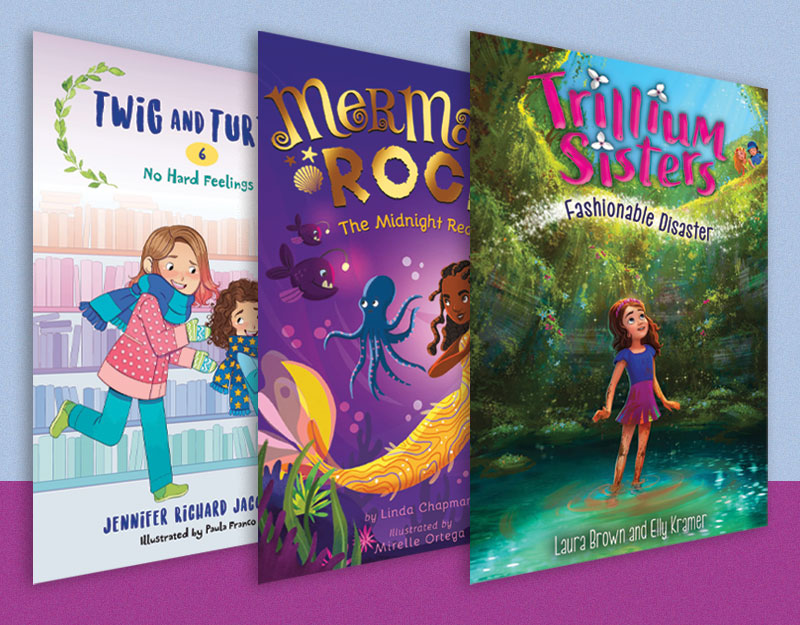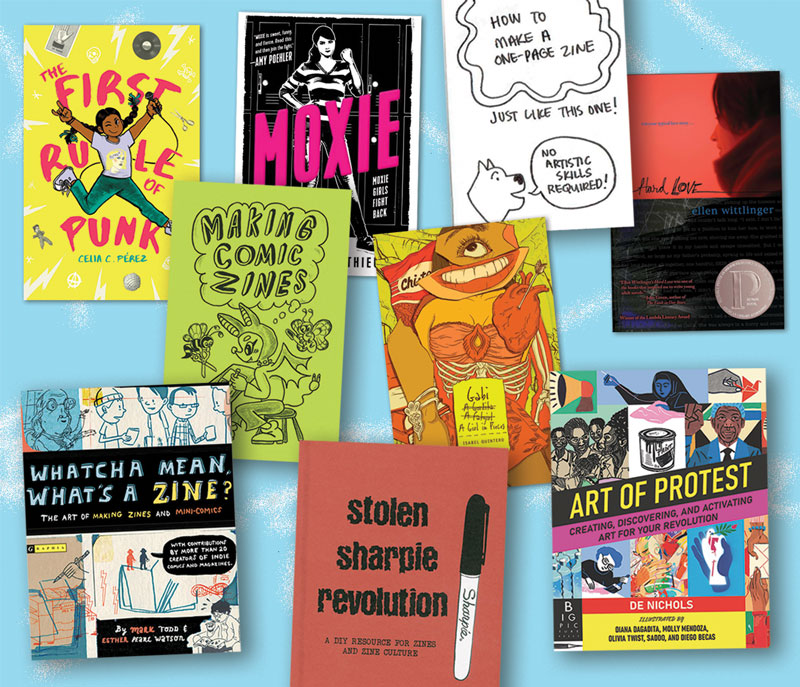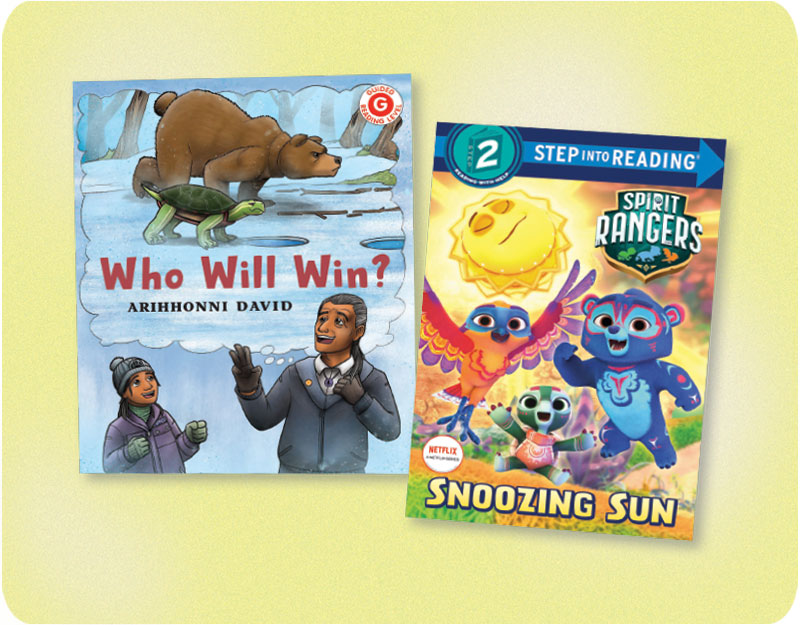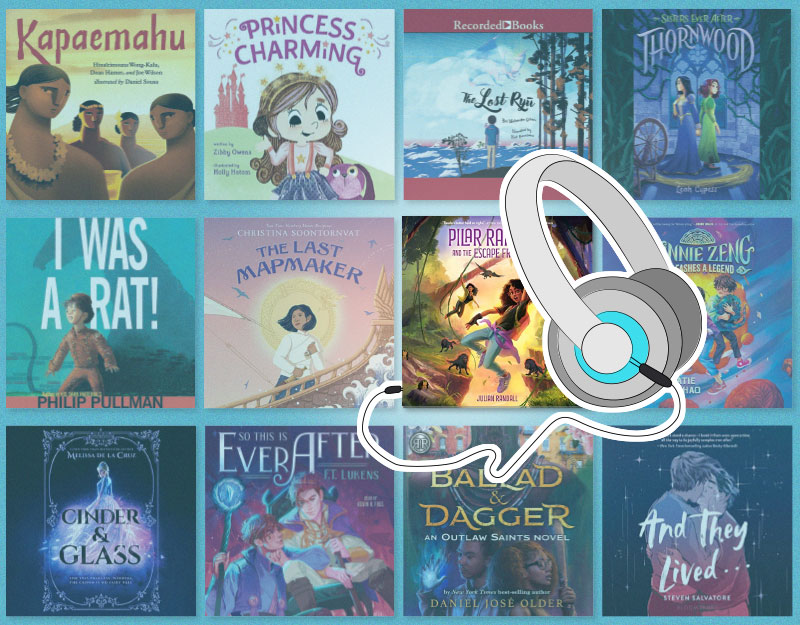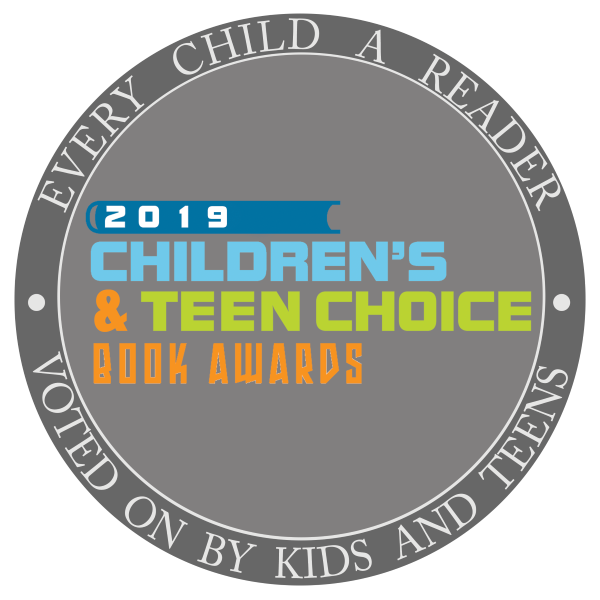Me… Jane & The Watcher
Written and Illustrated by Patrick McDonnell
Published in 2011 by Little, Brown and Co., ISBN 978-0-316-04546-9
All Ages.
Written and Illustrated by Jeanette Winter
Published in 2011 by Schwartz and Wade Books, ISBN 978-0-375-86774-3
All ages.
From an early age, Jane Goodall loved the outdoors, carefully observed the animals around her, and dreamed of a life in Africa, “a life living with, and helping, all animals.” Goodall’s childhood passions and dreams are the subject of this perfectly paced picture book biography by cartoonist and author McDonnell. Mixed media illustrations include images of pages from Goodall’s childhood journal, ornamental engravings from the late nineteenth century, and photographs. In a series of three clever page turns, the book concludes with the young Jane falling asleep in bed with her stuffed animal chimpanzee, then waking as a young adult in a tent in Africa, and finally portrayed in the famous photograph, reaching her hand out to a young chimp. The backmatter includes a more complete biography and a letter from Jane Goodall, herself. With its accessible, yet evocative text this beautiful book will inspire readers of all ages to pursue their dreams.
The Watcher Book Review
In her latest picture book biography, Jeanette Winter features the ever patient champion of primates, Jane Goodall. Beginning with her childhood fascination for the natural world (and attachment to her stuffed chimpanzee named Jubilee) and spanning her lifetime of scientific observation, discoveries, and advocacy, this richly illustrated text provides an inspiring overview of Goodall’s work. The acrylic and ink illustrations in Winter’s signature style and bold coloring shift from small framed images to full double page spreads as Goodall breaks free of her prescribed role as a woman to begin work in Africa with Louis Leakey. Readers will enjoy spotting small images of the chimpanzees that go unseen by Goodall as she surveys the lush landscape. Yet as months pass, she is accepted by the primates and they show themselves to her freely. Readers learn of the significant discoveries about primate behavior made by Goodall who “opened a window for us to the world of chimpanzees.”
ADVERTISEMENT
ADVERTISEMENT
Teaching Invitations
Grades K – 6
- Comparing Picture Book Biographies. Read aloud Me… Jane and then read aloud The Watcher. Invite students to discuss the similarities and differences between the two books. Ask students to consider which portion of Jane Goodall’s life has been emphasized by the author. Students will likely find it interesting that both authors chose to include young Jane’s chicken-watching incident. Why did both authors find this event significant? Spend some time discussing the role of the illustrations. How do the visual images enhance the narrative? What different affects are created by the different media?
- Picture Book Biography Genre Study. Conduct a genre study of picture book biographies featuring women and their accomplishments, such as Night Flight: Amelia Earhart Crosses the Atlantic by Robert Burleigh (see our blog entry for this title at http://classroombookshelf.blogspot.com/2011/04/night-flight-and-amelia-lost.html ) and Wangari’s Trees of Peace: A True Story of Africa, also by Jeanette Winter. A quick web search in Google for “picture book biographies women” will provide you with many additional titles. Read aloud several examples and collect students’ observations about the genre. Ask students to consider the choices authors make about how to tell the story of their subject, and which events in the subject’s life to emphasize. Consider the author’s writing style, format, and organizational choices. Discuss the role of the illustrations in a picture book biography. In a true picture book biography, the illustrations carry equal responsibility in conveying the characterization and featured events in the subject’s life. Students can use what they have learned about the genre to compose their own picture book biographies about a person whose life interests them.
- Scrapbooking or Collage. In Me… Jane, Patrick McDonnell uses collage technique reminiscent of scrapbook entries by incorporating engravings from the nineteenth and early twentieth centuries, photographs and images of journal entries. Invite students to use collage materials or scrapbooking techniques to create a poster highlighting the accomplishments of a person that they admire. If you have more time available, do the picture book biography genre study described above to provide students with mentor texts for composing and illustrating their own picture book biographies with this illustrative technique.
- Pursuing Dreams. Jane Goodall knew from an early age the work to which she wanted to devote her life. Ask your students to think and write about a dream that they have and to consider what they might need to do to achieve that dream. You might choose to make a class big book in which each student has a page to describe their goals.
- Observing Animal Behavior. Readers may find humor in Winters’s image of Jane Goodall’s tent overflowing with field note; however, students can learn a valuable lesson about the importance of careful documentation when engaged in scientific study. Have your students practice close observation with note-taking using the chimp cam linked below or an animal that can be observed more locally. If you are able to, invite someone who studies the behavior of animals to your classroom to talk about their observational techniques and documentation processes.
- Researching Chimps. Reading these picture books will likely inspire your students to want to know more about chimpanzees. After reading the books, ask students to list the questions that they have about these animals. Divide the class into inquiry groups to explore their questions through additional print and online resources. Ask each group to create a presentation of their findings using a multimedia composing tool such as Voice Thread.
- Studying Endangered Species. Winter’s title describes Jane Goodall’s study of chimpanzees in their natural habitat. Pair this title with other books that focus on animal study in the field, such as Sy Montgomery’s Kakapo Rescue: Saving the World’s Strangest Parrot (see our blog entry on this title at http://classroombookshelf.blogspot.com/2011/02/2011-robert-f-sibert-award-for.html ) and Quest for the Tree Kangaroo: An Expedition to the Cloud Forest of New Guinea, and books, such as Dan Bortolotti’s Panda Rescue: Changing the Future for Endangered Wildlife, which address conservation efforts in the wild and in animal sanctuaries. Ask students to consider the study of animals in the wild versus the study of animals in captivity. What is lost and what is gained in each of these scenarios? How do scientists vary their methods in each setting?
Critical Literacy
Grades 2 – 6
- Local Endangered Species. Jane Goodall is a fervent advocate for the preservation of endangered species. Use the website of the United States Fish and Wildlife Services (below) to identify endangered species in your area. How did these species come to be endangered? What efforts are being made to preserve the species? Ask students to consider what steps they might take to support the efforts.
- Books as Tools for Advocacy. These two titles featuring the life of Jane Goodall reflect the authors’ admiration for Jane and her efforts to protect the animals she loves. Jane Goodall herself has authored a picture book that serves as a plea to protect chimpanzees from hunters and habitat destruction. Read Rickie and Henry: A True Story aloud and discuss the genre of a picture book as a tool for advocacy. How might the stories of Jane’s life and the narrative of a young chimpanzee spur readers to action? How does the format of a picture book evoke an emotional response for readers? Invite your students to author or co-author a picture book as a vehicle to advocate for a particular cause to which they have a personal commitment.
Further Explorations
The Books of Patrick McDonnell
http://www.hachettebookgroup.com/features/patrickmcdonnell/book-me-jane.html
The Jane Goodall Institute
http://www.janegoodall.org/
National Wildlife Federation: Kids
http://www.nwf.org/kids.aspx
U.S. Fish and Wildlife Service: Endangered Species Program
http://www.fws.gov/endangered/
Roots & Shoots
http://www.rootsandshoots.org/
National Anthropological Archives
http://www.nmnh.si.edu/naa/index.htm
Bill Moyers: Interview with Jane Goodall
http://www1.teachertube.com/viewVideo.php?title=Jane_Goodall_PBS_part_1&video_id=172095
Animal Planet: Jane Goodall: Hope in Gombe
http://animal.discovery.com/fansites/janegoodall/janegoodall.html
TED: Jane Goodall on What Separates Us From the Apes
http://www.ted.com/talks/jane_goodall_on_what_separates_us_from_the_apes.html
Tulsa Zoo: Chimp Cam
http://chimps.tulsazoo.org/ChimpCam.htm
http://www.amnh.org/exhibitions/permanent/humanorigins/
Jane Goodall Biographies and Autobiographies
ADVERTISEMENT
ADVERTISEMENT
Goodall, J. (2000). Africa in my blood: An Autobiography in letters: The early years. Boston: Houghton Mifflin.
- This autobiography for an adult audience makes use of Jane Goodall’s letters and travel journals. Excerpts will be useful in the classroom.
Goodall, J. (1996). My life with the chimpanzees. New York: Aladdin Paperbacks.
- Jane Goodall describes how her early love of animals led to her work with chimpanzees in Gombe.
Greene, M. (2008). Jane Goodall: A Biography. Amherst, NY: Prometheus Books.
- A comprehensive biography written for a young adult audience. Includes black and white photos and a timeline.
- This early reader described the work of Jane Goodall. Part of the Scholastic News, Nonfiction Readers series.
- A biography of Jane Goodall intended for an intermediate grade audience, illustrated with cartoons and selected photographs.
- This text provides information about chimpanzees in the wild and in captivity; the book explains the dangers the species faces from poaching and destruction of habitat.
- This picture book describes how a chimpanzee mother teaches her child to use a stick as a tool to get food.
- Jane Goodall describes her learning about chimpanzee’s through years of intimate research in Gombe National Park; the concluding chapters stress the importance of preserving animal habitats.
- Jane Goodall describes the group of chimpanzees that she studied for many years in Africa.
- This informational text highlights the intelligence of chimpanzees and provides examples of positive human – chimp interactions.
- Part of the Animal Groups series, this title describes the behavior of chimpanzees.
Bortolotti, D. (2003). Panda rescue: Changing the future for endangered wildlife. Toronto: Firefly Books.
- A broad look at efforts in the field and in animal sanctuaries to protect Giant Pandas.
- A nail-biting narration of Amelia Earhart’s history-making flight across the Atlantic. See our blog entry on this title at http://classroombookshelf.blogspot.com/2011/04/night-flight-and-amelia-lost.html
- This picture book describes the plight of Rickie, an orphaned chimp, who adopts a shaggy dog as a substitute mother. A postscript describes the work of the Jane Goodall orphan sanctuary.
- Describes efforts to study and preserve the Kakapo parrots found on Codfish Island off the coast of New Zealand. Part of the Scientists in the Field Series. See our blog entry for this title at http://classroombookshelf.blogspot.com/2011/02/2011-robert-f-sibert-award-for.html
- The author accompanies a team of scientists who track and study the rare Matschie’s Tree Kangaroo in the Cloud Forest of New Guinea. Part of the Scientists in the Field series.
- A picture book biography of Wangari Maathai, a Nobel Prize winning environmentalist who took action against deforestation in Kenya.
Oppel, K. (2010). Half brother. New York: Scholastic.
- Thirteen year old Zan’s father, a behavioral psychologist brings home a baby chimp as a research project, asking Zan to treat the chimp as a brother.
- Like Jane Goodall, the fictional character Calpurina is an avid observer of nature, yet she, even more so than Dr. Goodall, faces the restrictions that society places on women. A young girl at the turn of the twentieth century, Calpurnia’s scientific interests are supported by her grandfather and a source of great distress to her mother.
- Deaf since the age of six, thirteen year old Joey befriends a chimpanzee and his scientist owner and learns sign language against her mother’s wishes.
Filed under: Biography & Memoirs, Nonfiction Picture Books, Picture Books
About Erika Thulin Dawes
Erika is a professor of language and literacy at Lesley University. A former classroom teacher, reading specialist, and literacy supervisor, she now teaches courses in children’s literature, early literacy, and literacy methods. Erika is the co-author of Learning to Write with Purpose, Teaching with Text Sets, and Teaching to Complexity.
ADVERTISEMENT
ADVERTISEMENT
SLJ Blog Network
Name That LEGO Book Cover! (#53)
Cover Reveal and Q&A: The One and Only Googoosh with Azadeh Westergaard
K is in Trouble | Review
Fighting Public School Book Bans with the Civil Rights Act
ADVERTISEMENT





